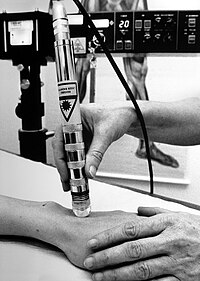
Photo from wikipedia
Simple Summary Radiotherapy is a mainstay in the treatment of pediatric ependymoma. It requires precise dose application and optimal protection of organs at risk to minimize long-term sequelae. Compared to… Click to show full abstract
Simple Summary Radiotherapy is a mainstay in the treatment of pediatric ependymoma. It requires precise dose application and optimal protection of organs at risk to minimize long-term sequelae. Compared to photon radiation treatment, proton therapy often achieves even better results regarding target coverage and organ-sparing. Due to their physical properties, helium ions could even further reduce side effects, providing better protection of healthy tissue despite similar target coverage. The present study reports the first in-depth dosimetric assessment of scanned helium ion plans compared to both state-of the art scanned protons and intensity modulated radiotherapy. Furthermore, the rationale and potential benefit of helium ions is substantiated by normal tissue complication probability analyses. Abstract Ependymomas are the third most-frequent pediatric brain tumors. To prevent local recurrence, the resection site should be irradiated. Compared to photon radiation treatment, proton therapy often achieves even better results regarding target coverage and organ-sparing. Due to their physical properties, helium ions could further reduce side effects, providing better protection of healthy tissue despite similar target coverage. In our in silico study, 15 pediatric ependymoma patients were considered. All patients underwent adjuvant radiotherapeutic treatment with active-scanned protons at Heidelberg Ion Beam Therapy Center (HIT). Both helium ion and highly conformal IMRT plans were calculated to evaluate the potential dosimetric advantage of ion beam therapy compared to the current state-of-the-art photon-based treatments. To estimate the potential clinical benefit of helium ions, normal tissue complication probabilities (NTCP) were calculated. Target coverage was comparable in all three modalities. As expected, the integral dose absorbed by healthy brain tissue could be significantly reduced with protons by up to −48% vs. IMRT. Even compared to actively scanned protons, relative dose reductions for critical neuronal structures of up to another −39% were achieved when using helium ions. The dose distribution of helium ions is significantly superior when compared to proton therapy and IMRT due to the improved sparing of OAR. In fact, previous studies could clearly demonstrate that the dosimetric advantage of protons translates into a measurable clinical benefit for pediatric patients with brain tumors. Given the dose–response relationship of critical organs at risk combined with NTCP calculation, the results of our study provide a strong rationale that the use of helium ions has the potential to even further reduce the risk for treatment related sequelae.
Journal Title: Cancers
Year Published: 2022
Link to full text (if available)
Share on Social Media: Sign Up to like & get
recommendations!